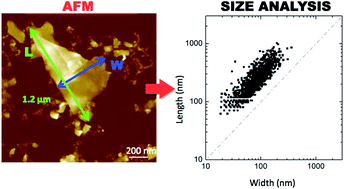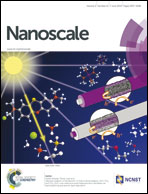Fragmentation and exfoliation of 2-dimensional materials: a statistical approach†
Abstract
The main advantage for applications of graphene and related 2D materials is that they can be produced on large scales by liquid phase exfoliation. The exfoliation process shall be considered as a particular fragmentation process, where the 2D character of the exfoliated objects will influence significantly fragmentation dynamics as compared to standard materials. Here, we used automatized image processing of Atomic Force Microscopy (AFM) data to measure, one by one, the exact shape and size of thousands of nanosheets obtained by exfoliation of an important 2D-material, boron nitride, and used different statistical functions to model the asymmetric distribution of nanosheet sizes typically obtained. Being the resolution of AFM much larger than the average sheet size, analysis could be performed directly at the nanoscale and at the single sheet level. We find that the size distribution of the sheets at a given time follows a log-normal distribution, indicating that the exfoliation process has a “typical” scale length that changes with time and that exfoliation proceeds through the formation of a distribution of random cracks that follow Poisson statistics. The validity of this model implies that the size distribution does not depend on the different preparation methods used, but is a common feature in the exfoliation of this material and thus probably for other 2D materials.


 Please wait while we load your content...
Please wait while we load your content...